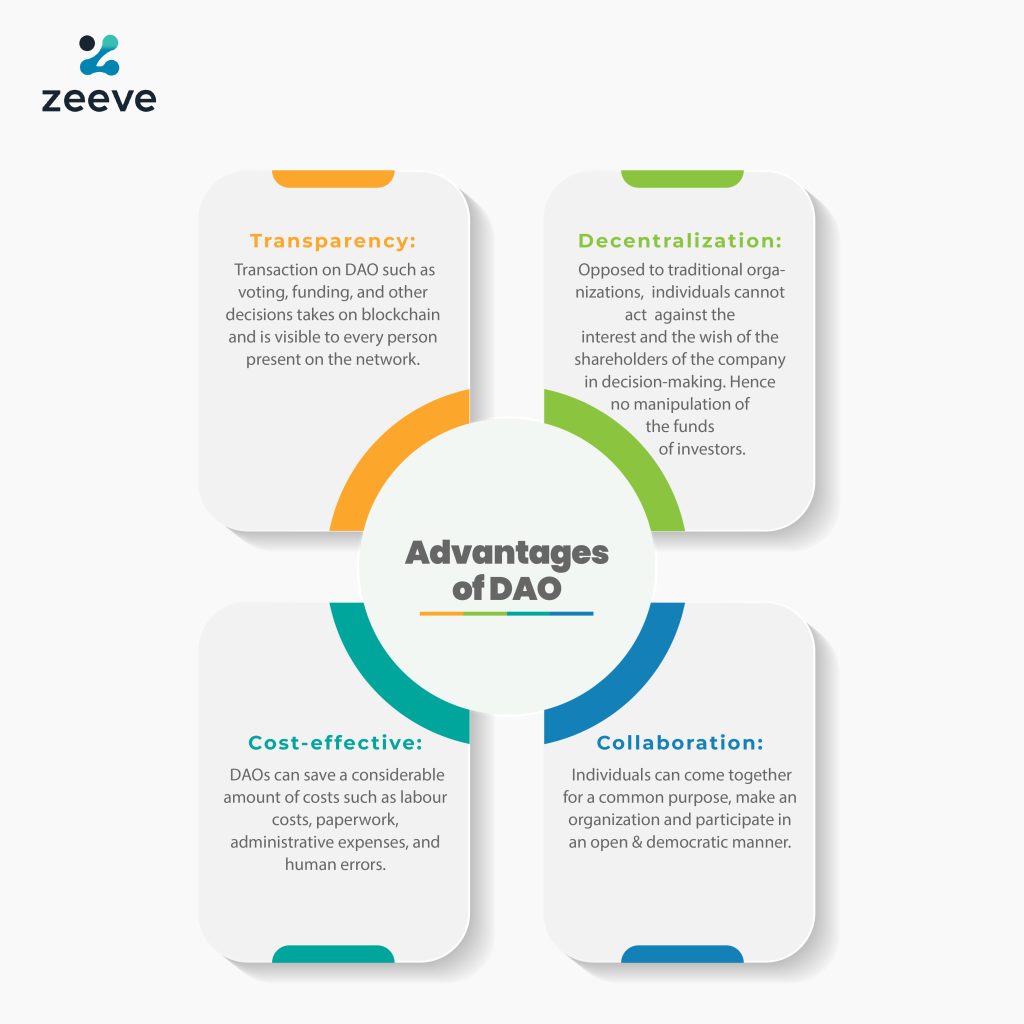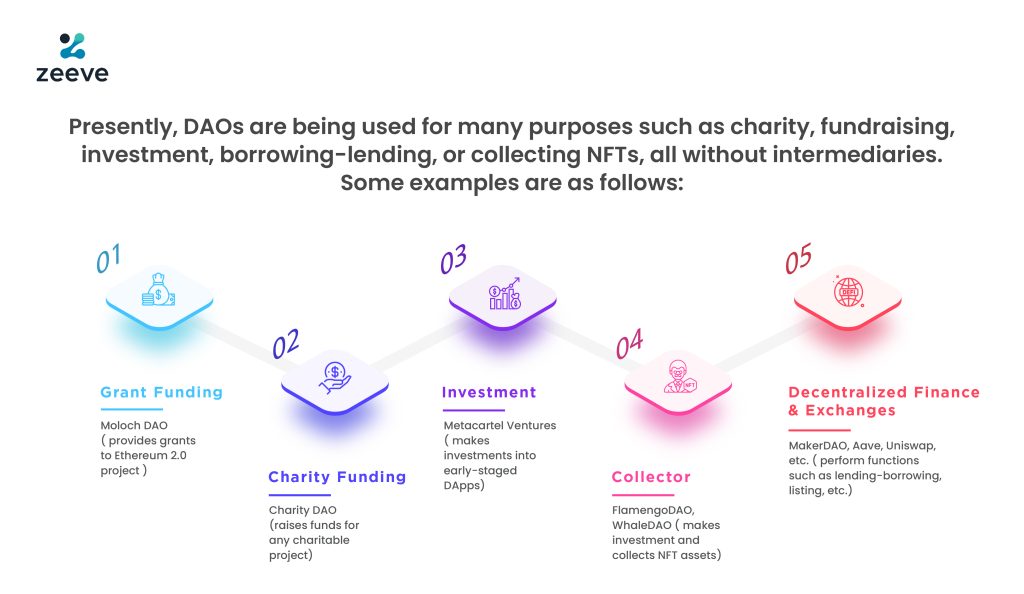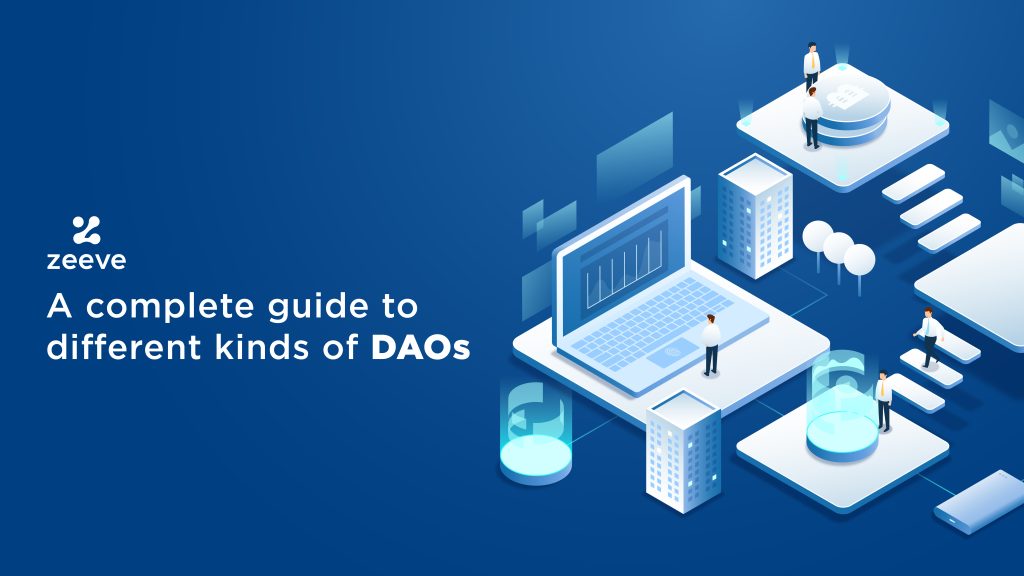The blockchain revolution has transformed the tech space like never before, offering users the promise of taking control away from centralized institutions and placing it firmly in their own capable hands. An intriguing advancement in the blockchain sector is Decentralized Autonomous Organizations (DAOs). A DAO is a form of self-governing digital entity that is powered by a network of participants running on blockchain technology disrupting traditional methods of finance, charity, and more.
As the world of blockchains and crypto grows up, launching DAOs is becoming a popular way of managing digital-native collectives on decentralized, secure, and trustless platforms. As the demand for understanding DAOs rises due to the decentralization benefits they offer, let’s dive deeper into what they are and how they work and what are the different types of DAOs.
Overview of DAOs
The two core principles governing the concept of DAOs are decentralized and autonomous. In context to the DAOs, there is no single entity that controls it, instead, it is managed by the collective effort of its members.
Being powered by blockchain technology, DAOs are typically governed by a set of rules that are programmed into the blockchain. These rules can be anything from how decisions are made to how funds are spent. Security of funds stored on DAOs and efficiency of these bodies demonstrated through quick and easy voting are what makes DAOs stand out from traditional, centralized organizations. Also, they are completely self-governing, facilitating a new way of organizing and running businesses, through which only a certain set of individuals come together and work towards their shared mission without the requirement of a centralized leader.
For example: A DAO was formed to support the Ukrainian Army, raising over $3 million in funds. This DAO is a great example of how individuals can unite around a common cause and use blockchain to make a difference.
DAOs have been used to launch a variety of projects, including decentralized exchanges, lending platforms, and investment funds. DAOs are poised to become a major force in the future of business. Before we explore the different types of DAOs, let’s take a quick look at the history of this revolutionary concept.
Read our article where we have discussed DAO- its pros, cons, legal status, and also how it is created in detail.
Going back in time: The Pioneering Decentralized Autonomous Organization
The history of DAOs has been marked by both setbacks and groundbreaking achievements. The world’s first DAO, was created using smart contracts, open-source technology, and focused on venture capitalism. Unfortunately, a vulnerability in the smart contracts resulted in a loss of 3.6 million ETH and ultimately financial ruin for the DAO. Despite this setback, the DAO has paved the way for many more successful DAOs to come.
Despite this initial setback, the emergence of DAOs has continued to evolve and inspire new possibilities with 2018 proving to be a groundbreaking period for the DeFi (Decentralized Finance) space, known as the Summer of DeFi. The period was marked with the success of innovative projects such as Compound Finance (COMP), Uniswap (UNI), and Aave (AAVE), thereby pushing the boundaries of decentralized finance on the Ethereum blockchain.
Over the years, there has been a remarkable evolution in the structures and operations of DAOs driven by a combination of technological advancements, and the lessons learned from early experiments. In the early stages, DAOs focused on a specific objective or sector and relied on basic voting mechanisms, where token holders could express their preferences and make decisions collectively. However, as the ecosystem matured, DAOs began to embrace more sophisticated governance models and nuanced decision-making processes.

Different Kinds of DAOs
There are several DAOs – each designed to serve different purposes within the blockchain ecosystem. Before deciding, an enterprise must be aware of the functioning and purpose of these different types of DAOs before deciding to launch or be a member of one, so as to ensure that the best one meets their goals. Here are a few examples of the different types of DAOs:
1. Protocol DAOs
Protocol DAOs are tailored to supervise various functions within decentralized protocols, such as borrowing and lending. With the help of protocol DAOs, these platforms can efficiently conduct their operations and decision-making processes.
Protocol DAO examples
MakerDAO: Operates on the Ethereum blockchain, allows users to lend and borrow tokens at adjustable interest rates and with flexible repayment terms. Holders of MKR governance tokens can engage in the decision-making process of the Maker Protocol. This includes voting on crucial matters such as determining the collateral requirements for collateralized debt positions (CDPs), setting annual borrowing limits, and determining a protocol shutdown plan in the event of an Ethereum crash.
Uniswap: Introduction of UNI, Uniswap’s governance token, provides the community with the ability to vote on the development and operations of Uniswap. UNI token holders have the authority to govern Uniswap, handle the management of the UNI community treasury funds, and control the protocol fee switch, among other things. Proposals for modifications to Uniswap must receive at least 25,000 affirmative UNI votes before they can be considered for further discussion.
Yearn Finance: Uses its YFI governance token to delegate funding to DAO Vaults.In the DAO vault ecosystem, approved DAOs can receive funding from YFI token holders. Andre Cronje, YFI’s founder, also designed Coordinape, a tool that can be used to allocate funds and also reward contributors. The purpose of this system is to bridge the gap that exists in the conventional HR and payroll system.
2. Grant DAOs
Grant DAOs are set up to empower enterprises to strategically utilize capital resources accrued from charitable donations, across the web3 ecosystem. The primary objective of a Grant DAO is to offer financial support to projects that drive meaningful change, ultimately working towards a future that is fairer and more sustainable.
The process of requesting and obtaining grants from a Grant DAO resembles the familiar procedure of applying for grants from conventional non-profit organizations. Interested parties submit proposals, which are then subject to community voting. The community establishes the criteria for successful proposals, encompassing factors such as project scope, required funding, potential impact, and the project team’s capabilities.
By introducing a transparent and democratic approach, Grant DAOs have the potential to revolutionize project funding, setting them apart from traditional organizations.
Grant DAO examples:
MolochDAO stands tall as a true embodiment of the Grant DAO concept, firmly rooted in the Ethereum ecosystem. By deploying its operations on the Ethereum mainnet, MolochDAO brings forth a revolutionary approach to collective decision-making and resource allocation. Its noble objective revolves around the selfless act of contributing capital with a singular purpose: to allocate funds towards the development and sustenance of Ethereum’s infrastructure, a crucial digital public good.
GitCoin DAO is a popular Grant DAO example, helping thousands of projects grow their open source ecosystems and distributed millions in funding
3. Philanthropy DAOs
Philanthropic DAOs are looking to advance the cause of social responsibility by uniting around a common mission to create a meaningful impact on the Web3 space. The purpose of these decentralized communities is to herald a significant change that can have a positive impact on the world by harnessing the capabilities of blockchain technology.
Philanthropy DAO Examples
Big Green DAO, the first nonprofit philanthropic DAO, is a revolutionary concept tied to Big Green, a well-known 501(c3) charity that focuses on educating people on how to grow food for better nutrition, mental health, and climate impact. This DAO was created to help restructure the grant-making process of the decade-old charity and improve its financial position.
The ability of DAOs to organize and execute quickly is a great demonstration of the potential of Web3. The best example that one can refer to is the instance when the UkraineDAO gathered more than $3 million in ETH to back the Ukrainian Army in the shortest span possible.
The task of supporting the Ukraine army by sending them sufficient funds was collectively taken up by members of PleasrDAO, Trippy Labs, and the Russian art collective Pussy Riot. With the help of these members, UkraineDAO has leveraged the ENS domain ukrainedao.eth to swiftly send donations to Ukrainian soldiers and support the Ukrainian organization Come Back Alive. The combination of the crypto-currency’s growing popularity and the ease of international transfers have enabled philanthropic DAOs to make a significant impact in unprecedentedly short time frames.
4. Social DAOs
Social Decentralized Autonomous Organizations (DAOs) provide a platform for like-minded people, like builders, artists, and creatives, to come together to seek both knowledge and opportunities. These DAOs nurture an environment where participants can learn new things while actively engaging in open projects, collaborative work and earning rewards. These DAOs, sometimes referred to as Creator DAOs, often possess a barrier to entry, such as requiring participants to possess a minimum number of tokens or an NFT, or to receive a personal invitation.
Social DAO Examples
Developer DAO: One of the finest examples in this category can be of a Developer DAO which is a body of web3 enthusiasts and web3 developers coming together for their shared objective of paving the way for the future of web3. Members with an exclusive invitation to their Discord server can be a part of their organization.
Friends With Benefits is a creator DAO centered on developing a community and promoting creativity. Access to Friends With Benefits requires the possession of 75 $FWB tokens, and after admission, members are given full access to interact with developers, artists, creators, and attend special events. Although DeFi was originally based on the principle of inclusivity, certain social DAOs derive their worth from exclusivity, cooperative efforts, and the positive effects of interpersonal networks.
5. Collector DAOs
Collector DAOs enable members to pool their resources together in order to collectively invest treasury funds into blue chip NFT art and other collectibles. Each member is then entitled to a share that is proportionate to their individual investment. By joining forces, members are able to leverage their collective resources to gain access to investments that may have otherwise been out of reach.
The emergence of collector DAOs, such as FlamingoDAO, has been linked to the popularity of Non-Fungible Tokens (NFTs). In 2021, the most expensive NFT to date, CryptoPunk #2890, was purchased for a staggering $760,000 USD.
Not to be outdone, ConstitutionDAO attempted to buy a first-edition copy of the United States Constitution in a Sotheby’s auction, and was able to raise a remarkable $47 million worth of ETH in a single week. Investors can gain immensely with the help of collector DAOs as it facilitates them with the chance to have adequate exposure to grab the most expensive NFTs with no risk of staking pools of financial resources from their end. Although not every DAO is guaranteed to pay off, it is certainly a unique and interesting way to diversify one’s investments.
6. Investment and Venture DAOs
Venture DAOs bring together capital from multiple sources in order to fund initiatives related to early stage web3 startups, protocols, and off-chain investments.Venture DAOs are disrupting the traditional investment landscape by offering a more inclusive and accessible approach. Diverse range of individuals can participate in the investment process, thereby allowing these entities to break down traditional barriers and empower a wider pool of investors.
Venture DAO Examples
MetaCartel, an independent organization also falls into the category of this type of DAOs providing finances and operational guidance to emerging decentralized applications (dApps).
There are a few notable venture DAOs worth mentioning. One is BessemerDAO, which is a platform launched by Bessemer Venture Partners, a San Francisco-based venture capital firm. BessemerDAO aims to share insights and resources related to the crypto industry.
7. Media DAOs
As opposed to a top-down approach, wherein content is created with a primary objective or affected by advertisers, Media DAOs reimagine regular media stages by producing content directed by the group. Imagine powers vested in the hands of the social media networks, where individuals within the network are not governed by corporate organizations to generate profits, instead they have a major slice of the profits from the decentralized organization.
Media DAO Examples
BanklessDAO is an autonomous organization whose purpose is to foster the expansion of banking-free money systems by promoting media, culture, and education connected to such systems. This venture strives to extend the reach of bankless money and make it available to more people.
Forefront is a popular media DAO that operates on a token-permissioned system. Its primary objective is to provide a platform for sharing media, financial data, and community insights related to social tokens, non-fungible tokens (NFTs), and other DAOs. The organization is governed by its members and guided by the FF guild leaders and dedicated staff members.
Media DAOs are especially effective in assisting burgeoning communities to reward their members as the crypto space and Web 3.0 culture continue to expand. I think
8. SubDAOs
A SubDAO is a novel form of DAO that consists of a select group of members, who work in collaboration to manage particular tasks such as operations, collaborations, advertising, finance, and funding. In short, it is a DAO to tackle the operational hurdle of delegating responsibility within a DAO, all while preserving the essence of decentralization, thereby providing a greater degree of specialization and efficiency.
SubDAO examples
The Balancer Protocol recognized the potential of its expanding DAO membership and proposed the formation of subDAOs to handle decision-making and implementation concerning DAO affairs, without the need for all proposals to be approved by the whole DAO. After a unanimous voting process, the Balancer DAO was able to successfully incorporate subDAOs into its system, allowing it to become a more efficient one.

Concluding thoughts
As the web3 space continues to expand and blockchain technology evolves, innovators are pushing the boundaries of what is possible through the use of DAOs. The success of existing DAOs speaks volumes about the power of blockchain and how it can be harnessed for the betterment of a community.
By utilizing smart contracts and on-chain governance, DAOs have enabled their community members to redefine how decisions are made, while providing innovative legal structures that are free from a central authority. We can envision DAOs being utilized in various sectors, including governance, arts, entertainment, and more. The technology behind DAOs holds the promise of creating inclusive and decentralized systems that challenge traditional power dynamics and foster innovation.
About Zeeve
To build and deploy a DAO(smart contract) you need access to a blockchain of your choice, Zeeve provides that. Know more on how DAOs are built, read our article. Zeeve is a cloud-agnostic automation platform with low-code capabilities that supports numerous blockchain protocols, as well as sophisticated analytics and monitoring of nodes and networks.























